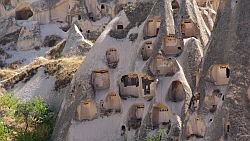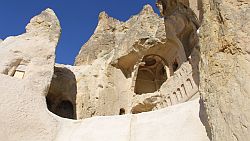Cave Dwellings of Cappadocia



In the center of Turkey, in the area of Cappadocia, an ancient eruption of volcanoes left the area covered in a layer of tufa, a soft rock up to one hundred meters thick. Three volcanoes, Erciyes, Hasan and Melendiz Daðlari erupted around 30 million years ago. Thousands of years ago the people of this area started to build underground cities into the volcanic tufa. It was not too difficult to build, as the tufa is very soft, and the housings are comfortable, warm in winter, cool in summer, and a good hideout in wartimes. Several underground cities in his area were built in this manner, which had up to one thousand inhabitants each. Around 200 separate underground structures were found so far. 36 are big enough to be called underground cities. The biggest are estimated that they were sufficient to hous up to 20,000 people for a short time, between some days and a few weeks, during a raid.
The earliest written account of the underground settlements is found in Xenophon’s Anabasis. According to this book, Hellenic communities lived underground at Kaymakli and Derinkuyu. This tells us, that underground cities existed in the 4th century BC, and probably even before. However, most of the currently known caves are from the 5th and 6th century AD. But it is very difficult to determine the age of the caves, except by their architectural style. Physical methods base on the decay of radioactive isotopes determine the age of cave content, especially carbon, but most caves were used over centuries and have no original content left.
Murals and monuments with inscriptions from the Hittite Empire (18th to 12th century BC) and the Neo-Hittite period (12th to 8th century BC) are sometimes found. The Hittites had a high standard of underground building techniques and constructed many military tunnels. The secret tunnels found in Hittite cities are called Potern. As a part of the defense systems of the Hittite towns they were generally used to ambush attackers. However, there are little decorations in military tunnels, so generally the high quality of the construction is interpreted to be of Hittite origin.
The area was christianized in the first century AD by St. Paul. During the Byzantine period, between the 5th and 10th century, some 360 churches and monasteries were built underground. Arab-Sassanid raids, which began in the 7th century, forced Christian communities to go underground. Their walls were decorated with religious paintings.
The word Cappadoccia comes from the Persian Katpatuka, which means "The Land of Fine Horses". Besides its horses, it was famous for its red ochre, ceramics and alabaster. Cappadocia is also famous for its wines, at least within Turkey.
- Underground Cities
 Ağırnas Yeraltı Şehri
Ağırnas Yeraltı Şehri Çukurören Yeraltı Şehri
Çukurören Yeraltı Şehri Derinkuyu Yeraltı Şehri
Derinkuyu Yeraltı Şehri Gaziemir Yer Altı Şehri
Gaziemir Yer Altı Şehri Kaymaklı Yeraltı Şehri
Kaymaklı Yeraltı Şehri Mazı Yeraltı Şehri
Mazı Yeraltı Şehri Nevşehir Yeraltı Şehri
Nevşehir Yeraltı Şehri Özkonak Yeralti Şehri
Özkonak Yeralti Şehri Özlüce Yeraltı Şehri
Özlüce Yeraltı Şehri Saratlı Kırkgöz Yeraltı Şehri
Saratlı Kırkgöz Yeraltı Şehri Sivasa Gökçetoprak Yeraltı Şehri
Sivasa Gökçetoprak Yeraltı Şehri Aziz Mercurius Yeraltı Şehri ve Kilisesi
Aziz Mercurius Yeraltı Şehri ve Kilisesi Tatlarin Yeraltı Şehri
Tatlarin Yeraltı Şehri
- Cave Hotels
 Akköy Evleri
Akköy Evleri Alfina Hotel
Alfina Hotel Altinocak Restaurant
Altinocak Restaurant Anatolian Houses
Anatolian Houses Ataman Hotel
Ataman Hotel Cappadocia Cave Resort & Spa
Cappadocia Cave Resort & Spa Cappadocia Cave Suites
Cappadocia Cave Suites Cappadocia Palace
Cappadocia Palace Dedeli Konak
Dedeli Konak Elkep Evi Cave Houses
Elkep Evi Cave Houses Esbelli Evi
Esbelli Evi Gamirasu Otel
Gamirasu Otel Katpatuka Cave Hotel
Katpatuka Cave Hotel Kayadem Cave Hotel
Kayadem Cave Hotel Kelebek Hotel
Kelebek Hotel Les Maisons De Cappadoce
Les Maisons De Cappadoce Les Terrasses d’Uchisar
Les Terrasses d’Uchisar Local Cave House
Local Cave House Monastery Cave Hotel
Monastery Cave Hotel Museum Hotel
Museum Hotel Paradise Pansiyon
Paradise Pansiyon Sacred House
Sacred House Selçuklu Evi
Selçuklu Evi Serinn
Serinn Star Cave Hotel
Star Cave Hotel Ürgüp Evi Cave Hotel
Ürgüp Evi Cave Hotel Vezir Cave Suites
Vezir Cave Suites Yunak Evleri
Yunak Evleri
- See also
 Search DuckDuckGo for "Cave Dwellings of Cappadocia"
Search DuckDuckGo for "Cave Dwellings of Cappadocia" Göreme National Park and the Rock Sites of Cappadocia (visited: 17-APR-2021)
Göreme National Park and the Rock Sites of Cappadocia (visited: 17-APR-2021) Underground Cities
Underground Cities Cappadocia
Cappadocia Cappadocia, Turkey
Cappadocia, Turkey What to do in Cappadocia, Turkey?
What to do in Cappadocia, Turkey? Livius Picture Archive: Cappadocia
Livius Picture Archive: Cappadocia Yeraltı Şehirleri
Yeraltı Şehirleri  (visited: 16-OCT-2020)
(visited: 16-OCT-2020) The Story Behind Turkey’s Underground Cities (visited: 23-FEB-2021)
The Story Behind Turkey’s Underground Cities (visited: 23-FEB-2021)
 Index
Index Topics
Topics Hierarchical
Hierarchical Countries
Countries Maps
Maps